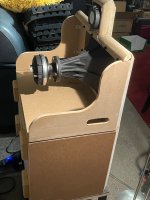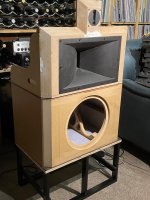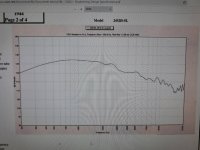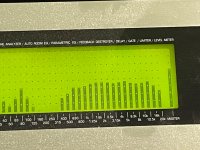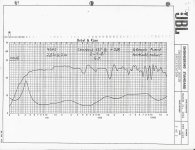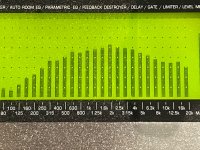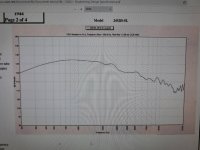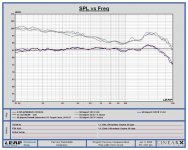I am building a pair of horn 3-way speakers for a buddy. I have zero experience with horns but decades of diy experience with cone and dome speakers. I assumed the usual diligence with control of edge diffraction and surface reflection by building the mid-range horn loaded JBL 2452H and super tweeter JBL 077 into a suitable frame with chamfered and rounded edges. The crossover between mid and super tweeter is active dsp at 6.4 kHz, Bessel 24 dB/Octave. The drivers are accurately time/phase aligned.
Here is the issue. A single speaker measures and sounds fine. However testing the stereo pair at the listening position with pink noise, lateral head movement produces clearly audible rapid phase cancellations and re-inforcements. I determined the main culprit is the mid-range horn loaded JBL 2452H by muting the super tweeters. Each mid-range performs adequately on its own without the phase swings but not together. In effect, comb-filtering to a degree I never experienced with any conventional cone/dome combination.
I am tending to the conclusion that horn loudspeakers, whilst able to perform adequately as a single mono speaker system, will not image accurately as a stereo pair.
Here is the issue. A single speaker measures and sounds fine. However testing the stereo pair at the listening position with pink noise, lateral head movement produces clearly audible rapid phase cancellations and re-inforcements. I determined the main culprit is the mid-range horn loaded JBL 2452H by muting the super tweeters. Each mid-range performs adequately on its own without the phase swings but not together. In effect, comb-filtering to a degree I never experienced with any conventional cone/dome combination.
I am tending to the conclusion that horn loudspeakers, whilst able to perform adequately as a single mono speaker system, will not image accurately as a stereo pair.
Attachments
Have you precision aligned the mic for this? Don't feel that it will be so bad listening, but you will get cancellations measuring them this way with only a small difference in distance.
It should be easy to do with a swinging boom and RTA.
It should be easy to do with a swinging boom and RTA.
Here is the issue. A single speaker measures and sounds fine. However testing the stereo pair at the listening position with pink noise, lateral head movement produces clearly audible rapid phase cancellations and re-inforcements.
Most probably the pink noise effect when moving your head has to do with the acoustics in your room.I am tending to the conclusion that horn loudspeakers, whilst able to perform adequately as a single mono speaker system, will not image accurately as a stereo pair.
Horn speakers have great image potential, as many members can testify. Maybe not in a bad acoustic environment, but that goes for every type of speaker.
I use exactly this technique. I have a DBX RTA measurement microphone and a number of RTA. From my photos you can see the super tweeter must be delayed relative to the mid-range to bring them into time alignment. The reverse null technique gives an almost perfect agreement with the physical distance offset of the 2 driver voice coils.Have you precision aligned the mic for this? Don't feel that it will be so bad listening, but you will get cancellations measuring them this way with only a small difference in distance.
It should be easy to do with a swinging boom and RTA.
Perfect in phase isn't always best. At this point I would begin guessing. I see that there could be much potential for directivity variation in your mid and tweeter region which might affect imaging with comb filtering. The only way to be sure would be to do polar measurements in various planes.
There will always be some comb filtering through the crossover range. All of my horns image just fine. Why are you crossing the 077's that low? 8K-9k would be a better place to cross them over.
Rob 🙂
Rob 🙂
I just compared JBL 077 vs JBL 075 clone and noticed imaging was more dense and focused with 075 type conical horn. 077 has 130 degrees of horizontal dispersion, which likely has higher potential for room interaction..
I found this FR for the JBL 2452H which agrees with what I measure on axis at 1m. It is 7-8 dB down at 4 kHz. Even at my crossover point of 4.2 kHz, it is stretching to reach the 077. Fortunately the 077 has a shelf up below 4 kHz which compensates for the mid-range fall. They sum quite nicely at 1m on listening axis, without any EQ.Why are you crossing the 077's that low? 8K-9k would be a better place to cross them over.
Rob 🙂
Attachments
It should, the lateral movement varies the path length distance between the speakers, which always causes that effect.The crossover between mid and super tweeter is active dsp at 6.4 kHz, Bessel 24 dB/Octave. Here is the issue. A single speaker measures and sounds fine. However testing the stereo pair at the listening position with pink noise, lateral head movement produces clearly audible rapid phase cancellations and re-inforcements.
The same phase cancellations and re-inforcements (comb filtering) would occur with any two speakers with correlated (mono) pink noise.
Most peoples hearing will be most sensitive to the comb filtering in the upper midrange (2-6kHz) covered by the mid horns.I determined the main culprit is the mid-range horn loaded JBL 2452H by muting the super tweeters.
The slot tweeters have wider horizontal dispersion than the mid horns, at 6.4kHz almost 140 degrees, (wider than many dome tweeters) so you hear more side wall reflections, "filling in" the peaks and dips.
The mid horn has much higher and more defined directivity in the upper midrange than most domes.In effect, comb-filtering to a degree I never experienced with any conventional cone/dome combination.
I find the opposite, an "accurate image" is more likely with more defined coverage patterns that avoid wall reflections.I am tending to the conclusion that horn loudspeakers, whilst able to perform adequately as a single mono speaker system, will not image accurately as a stereo pair.
Differences in stereo program and room reflection details are more apparent.
That said, the mid horn diffraction slot is located several wavelengths behind the high frequency slot.
The different points of acoustic origin will result in a wonky (inconsistent, comb-filtered) off-axis horizontal pattern in the crossover overlap region, a problem not shared by a typical cone/dome arrangement. The Bessel has the widest, most gradual crossover region compared to LR or BW filters, increasing the width of the "problem region".
That response is a 2" plane wave tube measurement, note that SPL at 200Hz is equal to 4kHz.I found this FR for the JBL 2452H which agrees with what I measure on axis at 1m. It is 7-8 dB down at 4 kHz.
It should not agree with the measurement on your horn.
The 2452's upper on-axis roll-off on a bi-radial horn should start ~7kHz, similar to this graph:
In the OP, you stated the crossover point was 6.4kHz, which should be a better choice for an 077.Even at my crossover point of 4.2 kHz, it is stretching to reach the 077. Fortunately the 077 has a shelf up below 4 kHz which compensates for the mid-range fall. They sum quite nicely at 1m on listening axis, without any EQ.
Art
Last edited:
I found this FR for the JBL 2452H which agrees with what I measure on axis at 1m. It is 7-8 dB down at 4 kHz. Even at my crossover point of 4.2 kHz, it is stretching to reach the 077. Fortunately the 077 has a shelf up below 4 kHz which compensates for the mid-range fall. They sum quite nicely at 1m on listening axis, without any EQ.
So you are using the 2380 without CD compensation. As previously stated you should be using the 2380 without EQ as your reference plot. This is the effect of path length differences in a 4345 between the 2405 and the mid-horn. You can see the comb filtering around the 10K crossover point.
Rob 🙂
Attachments
Last edited:
I mis-typed. The crossover is at 6.4 kHz. Thanks for the correction Art.I found this FR for the JBL 2452H which agrees with what I measure on axis at 1m. It is 7-8 dB down at 4 kHz. Even at my crossover point of 4.2 kHz, it is stretching to reach the 077. Fortunately the 077 has a shelf up below 4 kHz which compensates for the mid-range fall. They sum quite nicely at 1m on listening axis, without any EQ.
I will show the measured FR at 1m of each driver separately in a future post.
Well yeah of course they do. That's the mass roll off point. You are using a CD horn. That is the expected response. The on axis response follows the drivers response. An exponential will EQ the on axis response based on the increase in directivity as frequency rises. Two different animals. You can easily EQ the 2452 by attenuating the midrange response. You should really have some attenuation.
Rob 🙂
Rob 🙂
Attachments
Last edited:
As I mentioned in my original post, I have no experience with horn loaded speakers. This build is for a friend who has experience of horn applications. I am assessing the speaker before handing them over. The brief was to make an effort to overcome the poor design of classical JBL enclosures, which have little regard for flush mounting of drivers, cabinet edge diffraction, baffle surface reflection, driver time alignment, cabinet bracing etc. The expectation is that, together with careful crossover implementation there should be a noticeable improvement in imaging over crude enclosure design.
It is interesting that it accepted that horn designs require significant EQ to meet accuracy goals. It appears to me that you will give up important qualities when forced to EQ the mid-range. When you have to attenuate the mid-range horn (650 Hz- 6.4 kHz), surely your efficiency advantage is gone? Furthermore, EQ does not just affect amplitude. There will be phase shift as well.
I accept that my experience with traditional drivers does not necessarily give me the insight to properly investigate horn speakers. The end-user will be better placed to appraise the results.
Thanks everyone who tried to educate me. I am inspired to spend some time looking at the foundations.
https://www.grc.com/acoustics/an-introduction-to-horn-theory.pdf
https://audioxpress.com/assets/upload/files/kolbrek2885.pdf
It is interesting that it accepted that horn designs require significant EQ to meet accuracy goals. It appears to me that you will give up important qualities when forced to EQ the mid-range. When you have to attenuate the mid-range horn (650 Hz- 6.4 kHz), surely your efficiency advantage is gone? Furthermore, EQ does not just affect amplitude. There will be phase shift as well.
I accept that my experience with traditional drivers does not necessarily give me the insight to properly investigate horn speakers. The end-user will be better placed to appraise the results.
Thanks everyone who tried to educate me. I am inspired to spend some time looking at the foundations.
https://www.grc.com/acoustics/an-introduction-to-horn-theory.pdf
https://audioxpress.com/assets/upload/files/kolbrek2885.pdf
The choice of using a constant directivity horn is (should be..) an acceptance of it's requirements.It is interesting that it accepted that horn designs require significant EQ to meet accuracy goals.
Horns can and have been designed to compensate for the diaphragm's mass roll off and have flat on axis response with little EQ. The penalty is a narrow high frequency coverage region, a "beamy horn".
No, the efficiency advantage is still there- if you attenuate by 6dB, the driver sees only 1/4 the power in that range.When you have to attenuate the mid-range horn (650 Hz- 6.4 kHz), surely your efficiency advantage is gone?
That said, if you are using DSP, there is no resistive loss of power, no loss in sensitivity.
To provide similar SPL levels, a dome driver may require 10 times the power, which results in voice coil heating, doubling (or more) impedance, which lowers sensitivity by 3dB or more, "thermal compression".
The phase shift is a good feature, corrective EQ will also flattens the phase response.Furthermore, EQ does not just affect amplitude. There will be phase shift as well.
Art
Horns have too many variables for that not to be the case, but there are many harmless reasons for EQing as well as some that aren't.It is interesting that it accepted that horn designs require significant EQ to meet accuracy goals.
When you have to attenuate the mid-range horn (650 Hz- 6.4 kHz), surely your efficiency advantage is gone?
Well if you were doing a passive crossover you would have to match the woofers sensitivity. Active you have to do that as well. One thing I would say you should consider is adding a 10 dB passive pad on the Mid/Hf. This will reduce the hiss levels from the midrange and 077's.
Rob 🙂
- Home
- Loudspeakers
- Multi-Way
- Horn stereo pair
